GATE 2024 Sociology (XH-C6) Question Paper PDF is available here. IISc Banglore conducted GATE 2024 Sociology (XH-C6) exam on February 4 in the Forenoon Session from 9:30 AM to 12:30 PM. Students have to answer 65 questions in GATE 2024 Sociology (XH-C6) Question Paper carrying a total weightage of 100 marks. 10 questions are from the General Aptitude section and 55 questions are from Core Discipline.
GATE 2024 Sociology (XH-C6) Question Paper with Answer Key PDF
| GATE 2024 Sociology (XH-C6) Question Paper with Answer Key PDF | Download PDF | Check Solutions |
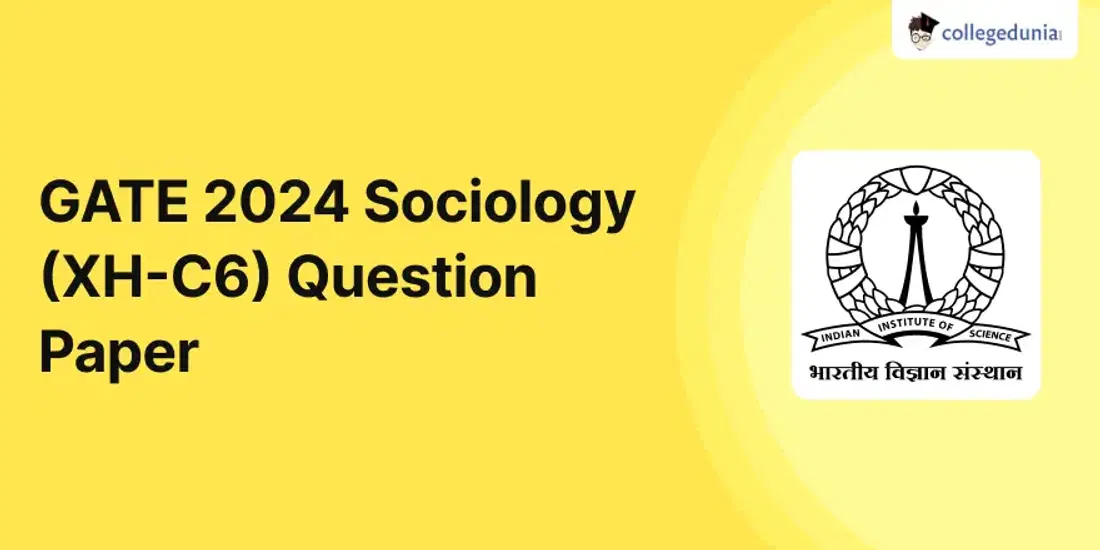
GATE 2024 Sociology (XH-C6) Question Paper Solutions
If \( \to \) denotes increasing order of intensity, then the meaning of the words [simmer \( \to \) seethe \( \to \) smolder] is analogous to [break \( \to \) raze \( \to \) _______].
Which one of the given options is appropriate to fill the blank?
In a locality, the houses are numbered in the following way:
The house-numbers on one side of a road are consecutive odd integers starting from 301, while the house-numbers on the other side of the road are consecutive even numbers starting from 302. The total number of houses is the same on both sides of the road.
If the difference of the sum of the house-numbers between the two sides of the road is 27, then the number of houses on each side of the road is
For positive integers \( p \) and \( q \), with \( \frac{p}{q} \neq 1 \), \( \left(\frac{p}{q}\right)^q = p^{(q-1)} \). Then,
Which one of the given options is a possible value of \( x \) in the following sequence?
\[ 3, 7, 15, x, 63, 127, 255 \]
On a given day, how many times will the second-hand and the minute-hand of a clock cross each other during the clock time 12:05:00 hours to 12:55:00 hours?
In the given text, the blanks are numbered (i)–(iv). Select the best match for all the blanks.
Text:
From the ancient Athenian arena to the modern Olympic stadiums, athletics ____ (i) ____ the potential for a spectacle. The crowd ____ (ii) ____ with bated breath as the Olympian artist twists his body, stretching the javelin behind him. Twelve strides in, he begins to cross-step. Six cross-steps ____ (iii) ____ in an abrupt stop on his left foot. As his body ____ (iv) ____ like a door turning on a hinge, the javelin is launched skyward at a precise angle.
Three distinct sets of indistinguishable twins are to be seated at a circular table that has 8 identical chairs. Unique seating arrangements are defined by the relative positions of the people. How many unique seating arrangements are possible such that each person is sitting next to their twin?
The chart below compares the Installed Capacity (MW) of four power generation technologies, T1, T2, T3, and T4, and their Electricity Generation (MWh) in a time of 1000 hours (h).

The Capacity Factor of a power generation technology is defined as:
Capacity Factor = \(\frac{Electricity Generation (MWh)}{Installed Capacity (MW) × 1000 (h)}\)
Which one of the given technologies has the highest Capacity Factor?
In the \( 4 \times 4 \) array shown below, each cell of the first three columns has either a cross (X) or a number, as per the given rule.

Rule: The number in a cell represents the count of crosses around its immediate neighboring cells (left, right, top, bottom, diagonals).
As per this rule, the maximum number of crosses possible in the empty column is:
During a half-moon phase, the Earth-Moon-Sun form a right triangle. If the Moon-Earth-Sun angle at this half-moon phase is measured to be \(89.85^\circ\), the ratio of the Earth-Sun and Earth-Moon distances is closest to:
Amma’s tone in the context of the given passage is that of:
For Amma, the difference between men and women was a kind of discrimination and inequality; she felt strongly about women’s rights but was not familiar with concepts like gender and patriarchy. She would have dismissed Betty Friedan because she was predominantly dealing with the problems of white middle-class women in the United States. Amma, and women of her generation, could de-link the oppression of women from the wider struggle for the liberation of human beings from class exploitation and imperialism. So Amma continued to play her role as mother and wife, but would often complain: ‘I am a doormat on which everyone wipes their emotional dirt off’.
Fill in the blanks by choosing the correct sequence for the following passage:
I am wearing for the first time some (i)------ that I have never been able to wear for long at a time, as they are horribly tight. I usually put them on just before giving a lecture. The painful pressure they exert on my feet goads my oratorical capacities to their utmost. This sharp and overwhelming pain makes me sing like a nightingale or like one of those Neapolitan singers who also wear (ii)------ that are too tight. The visceral physical longing, the overwhelming torture provoked by my (iii)------, forces me to extract from words distilled and sublime truths, generalized by the supreme inquisition of the pain my (iv)----- suffer.
The appropriate synonym for the word ‘ignite’ in the following passage will be:
Spirituality must be integrated with education. Self-realization is the focus. Each one of us must become aware of our higher self. We are links of a great past to a grand future. We should ignite our dormant inner energy and let it guide our lives. The radiance of such minds embarked on constructive endeavor will bring peace, prosperity, and bliss to this nation.
Which of the following sentences is punctuated correctly?
Fill in the blanks with the correct combination of tenses for the given sentence:
\(\textit{Darwin’s}\) work (i) ----- a related effect that (ii) ----- influenced the development of environmental politics – a ‘decentering’ of the human being.
Which of the following options holds a similar relationship as the words, ‘Music: Notes’?
In a particular code, if “RAMAN” is written as 52 and “MAP” is written as 33, then how will you code “CLICK”?
On the basis of the statements given below, which valid assumption(s) can be made?
Statements:
Life has suffering.
Desire is the cause of suffering.
The end of desire is the end of suffering.
Desire can be reduced by following the noble eightfold path.
Assumptions:
If ‘KARAMCHAND’ is coded as ‘ICPCKEFCLF’ what should be the code of ‘CREATION’?
Given an input line of numbers and words, a machine rearranges them following a particular rule in each step. Here is an illustration of an input and rearrangement sequence (Step 1 to Step 5):
Input: 61 wb ob 48 45 29 34 sb pb lb
Step 1: lb wb ob 48 45 29 34 sb pb 61
Step 2: lb ob wb 45 29 34 sb pb 61 48
Step 3: lb ob pb wb 29 34 sb 61 48 45
Step 4: lb ob pb sb wb 29 61 48 45 34
Step 5: lb ob pb sb wb 61 48 45 34 29
Based on the rules followed in the above steps, answer the following question:
Input: cb kb eb 58 49 23 38 jb nb gb 69 82
Which of the following represents the position of 58 in the fourth step? (Step-5 is the last step of the arrangement.)
In a certain type of code, ‘they play cricket together’ is written as ‘mv kb lb iv’; ‘they score maximum points’ is written as ‘gb lb mb kv’; ‘cricket score earned points’ is written as ‘mb gv kb kv’ and ‘points are earned together’ is written as ‘kv mv ob gv.’
What is the code for ‘earned maximum points’?
Which of the statement(s) about the passage weaken(s) the argument presented?
Scientists associate large brains with greater intelligence. However, in the evolutionary context, it has also been identified that beyond a point, the size of the brain has not increased and yet after a particular period, in spite of no significant change in brain size, humans have made significant progress. Certain researchers propose that this is because, while the overall brain size may not have changed, marked structural changes can be noticed in specific structures that run parallel to an increase in human intelligence.
The narrator’s use of ‘I’ in the given passage is/are:
I have never been any good at the more lurid sort of writing. Psychopathic killers, impotent war-heroes, self-tortured film stars, and seedy espionage agents must exist in the world, but strangely enough I do not come across them, and I prefer to write about the people and places I have known and the lives of those whose paths I have crossed. This crossing of paths makes for stories rather than novels, and although I have worked in both mediums, I am happier being a short-story writer than a novelist.
Which of the following recommended action(s) seem to be appropriate with the stated problem?
Stated problem: Many students at educational institutes do not attend classes in the post-pandemic scenario.
Read the passage and identify the statement(s) which follow(s) from it:
The purpose of this work is to inform educators about the brain science related to emotion and learning, and, more important, to offer strategies to apply these understandings to their own teaching. Although many of the approaches I describe will be familiar, integrating the lens of emotion and the brain may be a new concept. As an educator I had been trained in how to deliver content and organize my lessons, but I had not been taught how to design learning experiences that support emotions for learning.
If A says that his mother is the daughter of B’s mother, then how is B related to A?
Fill in the blank with the correct option.
According to Thomas Kuhn, activities of normal science are like puzzle solving, since they seek to reach __________ that include solving instrumental, conceptual and methodological problems within the confines of certain rules.
View Solution
Step 1: Understand the concept of normal science.
According to Thomas Kuhn, normal science operates within an established framework (paradigm) and aims to solve problems that are consistent with this framework. These activities resemble puzzle solving as they aim to extend or refine the existing paradigm.
Step 2: Analyze the given statement.
The blank must describe the goal of normal science, which involves achieving results (conclusions) within the boundaries of existing scientific methods and frameworks.
Step 3: Evaluate the options.
Option (A): new conclusions in existing ways aligns with the idea of extending the paradigm by solving problems within its confines.
Option (B): existing conclusions in new ways is incorrect because normal science does not aim to reinterpret known conclusions but to refine or extend them.
Option (C): new publishers is unrelated to the scientific activities described.
Option (D): new junior researchers is irrelevant to the goal of normal science.
Step 4: Conclusion.
The correct answer is (A) new conclusions in existing ways. Quick Tip: When solving questions about scientific theories or philosophies, focus on the core principles described in the text to identify the most suitable option.
‘We are constantly doing gender without realizing it.’
Select one of the given options that best explains the above statement.
View Solution
Step 1: Understand the context of the statement.
The statement "We are constantly doing gender without realizing it" suggests that gender is not merely an innate characteristic but rather a continuous, unconscious social behavior. This aligns with sociological theories, such as Judith Butler's concept of gender performativity, which proposes that gender is constructed through repeated actions and behaviors.
Step 2: Analyze the options.
Option (A): We socially construct our behaviours to perform our gender roles. This directly aligns with the idea that gender is performed through socially learned behaviors and expectations.
Option (B): Biological sex determines our gender identities. This is incorrect as the statement emphasizes the performative aspect of gender, not its biological basis.
Option (C): Gender is not a performance; it is an identity. This contradicts the idea presented in the statement, which views gender as a performance.
Option (D): Gender performance is about individual determinism. This is incorrect as gender performance is shaped by societal norms and not purely individual choices.
Step 3: Conclusion.
The correct answer is (A) We socially construct our behaviours to perform our gender roles. Quick Tip: When analyzing questions on sociological theories, focus on key concepts like social constructs, norms, and behaviors to identify the most relevant option.
Normal distribution is widely used in quantitative analysis in social sciences. Which of the given statements is NOT correct about the normal distribution?
Which one of the given statements is NOT correct?
Fill in the blank with the correct option.
According to Ray Oldenberg, ________ are social surroundings different from home and workplaces which are important for civil society, democracy and civic engagement.
View Solution
Step 1: Understanding the concept of "Third Places."
According to Ray Oldenburg, "third places" refer to informal gathering places that are distinct from the "first place" (home) and the "second place" (workplaces). These places play a critical role in fostering civil society, encouraging social interaction, and promoting democracy and civic engagement.
Step 2: Analyze the options.
(A): Instagram and YouTube are virtual platforms, not physical social surroundings as defined by Oldenburg.
(B): Villages are geographical units and do not fit the specific concept of "third places."
(C): Correct. Third places such as cafes, parks, and community centers align with Oldenburg's definition.
(D): Districts refer to administrative or geographical areas and are not "third places."
Step 3: Conclusion.
The correct answer is (C) "Third places," as they match Ray Oldenburg's concept. Quick Tip: "Third places" are vital for creating a sense of community and encouraging casual social interactions beyond the home and workplace.
Fill in the blank with the correct option.
Paul Lazarsfeld and Robert Merton coined the term ________ to explain the phenomenon wherein media provides a massive amount of coverage that the audience becomes numb and fails to act on the information, regardless of how compelling the issue.
View Solution
Step 1: Understanding the concept of "Narcotizing Dysfunction."
The term "narcotizing dysfunction" was introduced by Paul Lazarsfeld and Robert Merton to describe a phenomenon where excessive exposure to media information leads to apathy among the audience. Instead of taking action on the information, the audience feels overwhelmed and passive, thus failing to engage with the issue.
Step 2: Analyze the options.
(A): "Dysfunctional media" is a general term and does not specifically address the phenomenon described.
(B): Correct. "Narcotizing dysfunction" accurately describes the audience's numbness and inaction due to information overload.
(C): "Manufacturing consent," a term by Noam Chomsky and Edward Herman, refers to media manipulation to shape public opinion, not the phenomenon in question.
(D): "Echo chamber" refers to a situation where beliefs are amplified by repeated exposure within a closed system, not to audience apathy.
Step 3: Conclusion.
The correct answer is (B) "narcotizing dysfunction," as it matches the concept described by Lazarsfeld and Merton. Quick Tip: "Narcotizing dysfunction" highlights the unintended consequence of excessive media exposure leading to public inaction, emphasizing the need for balanced media consumption.
Fill in the blank with the correct option.
According to Max Weber, social stratification is a function of ____________.
View Solution
Step 1: Understanding Max Weber's theory of social stratification.
Max Weber proposed that social stratification is multidimensional, involving economic factors (class), social factors (status), and political factors (power). He argued that stratification cannot be explained by economic factors alone but also involves social and political dynamics.
Step 2: Analyze the options.
(A): "Economic factors only" is incorrect as Weber included more than economic factors.
(B): Correct. Weber emphasized the roles of economic and social factors in stratification.
(C): "Honour and status only" does not encompass the economic and political aspects Weber discussed.
(D): "Political power and status only" is incomplete as it excludes economic factors.
Step 3: Conclusion.
The correct answer is (B) "economic and social factors," as Weber's approach highlights both dimensions in addition to political factors. Quick Tip: Max Weber's theory of social stratification emphasizes the interplay of class, status, and power, providing a comprehensive view of social inequalities.
Fill in the blank with the correct option.
According to Durkheim, collective consciousness and division of labour in a given society would be ____________ to each other.
View Solution
Step 1: Understanding Durkheim's perspective.
Durkheim in his work on the division of labour emphasized that as the division of labour in a society increases, collective consciousness (shared beliefs and values) tends to decrease. This is because specialized roles lead to individualism, reducing the need for a strong collective consciousness.
Step 2: Analyze the options.
(A): "Directly related" is incorrect because collective consciousness weakens with increased division of labour.
(B): Correct. Durkheim proposed that collective consciousness and division of labour are inversely related.
(C): "Not related" is incorrect as Durkheim clearly establishes a relationship between the two concepts.
(D): "Dialectically related" is not the term Durkheim uses to describe the relationship.
Step 3: Conclusion.
The correct answer is (B) "inversely related," as per Durkheim's theory. Quick Tip: Emile Durkheim's theory highlights that as societies become more complex, the division of labour increases, leading to a decline in collective consciousness and a rise in individualism.
Fill in the blank with the correct option.
__________________________ argued for a shift in social movements post-1968 towards questions of self-management and technologies of rule as central driving concerns, analyzing these movements as struggles over the self-production of society.
View Solution
Step 1: Understanding the context of the question.
Alain Touraine, a prominent sociologist, extensively analyzed social movements post-1968. He argued for a paradigm shift in understanding social movements, focusing on self-management, technologies of rule, and the self-production of society. These themes became central to his analysis of how movements operate beyond traditional frameworks.
Step 2: Evaluate the options.
(A): Eric Hobsbawm primarily focused on the history of labor and revolutionary movements but did not specifically emphasize the self-production of society in the context described.
(B): Alain Touraine is correct as he argued for this specific shift in analyzing social movements post-1968.
(C): Henri Lefebvre’s work emphasized the critique of everyday life and urban spaces, which does not align with the focus on self-management and technologies of rule.
(D): Michel Foucault focused on power and technologies of rule but not explicitly within the framework of post-1968 social movements as described here.
Step 3: Conclusion.
The correct answer is (B) Alain Touraine, as his work directly relates to the ideas of self-management and the self-production of society in the context of social movements. Quick Tip: Alain Touraine's theory emphasizes the transition in social movements, focusing on cultural, technological, and societal self-production rather than traditional economic or political struggles.
The recognition that social identities are multi-layered, often overlapping, and non-discrete, comes from which of the following conceptual frameworks?
The movement against _______ dam in India has contributed significantly to the formation of the World Commission on Dams.
View Solution
Step 1: Understanding the context of the movement against the Sardar Sarovar Dam.
The Sardar Sarovar Dam, constructed on the Narmada River, became a significant point of contention due to its large-scale displacement of people, environmental concerns, and the impact on the ecosystem. The Narmada Bachao Andolan (NBA), led by activists like Medha Patkar, brought international attention to these issues.
Step 2: Formation of the World Commission on Dams.
The protests against the Sardar Sarovar Dam played a key role in highlighting the need for better assessment of the environmental and social impacts of large dam projects worldwide. This contributed significantly to the establishment of the World Commission on Dams, which aimed to address such concerns globally.
Step 3: Evaluate the options.
(A) Koel Karo dam project faced resistance but is unrelated to the formation of the World Commission on Dams.
(B) Tehri Dam also faced opposition, but it is not associated with the formation of the World Commission on Dams.
(C) Sardar Sarovar is the correct answer, as the protests against this dam were instrumental in establishing the commission.
(D) Subansiri dam has faced opposition, but it is not connected to the World Commission on Dams.
Step 4: Conclusion.
The correct answer is (C) Sardar Sarovar, as the movement against this dam significantly influenced the formation of the World Commission on Dams. Quick Tip: The Narmada Bachao Andolan is a landmark movement in India that highlights the social and environmental implications of large-scale dam projects.
Which thinker is associated with the concept of participatory development?
View Solution
Step 1: Understanding Participatory Development.
Participatory development is a process that emphasizes involving local populations in the planning and implementation of development projects. This approach seeks to empower communities, ensure sustainability, and address the specific needs of stakeholders.
Step 2: Thinkers and their contributions.
(A) André Béteille: A renowned Indian sociologist, Béteille is known for his work on caste, class, and inequality but is not associated with participatory development.
(B) Robert Chambers: Chambers is a prominent advocate of participatory rural development and has significantly contributed to the theory and practice of participatory methods in development.
(C) Andre Gunder Frank: Known for his work on dependency theory, Frank is not associated with participatory development.
(D) Robert Putnam: Known for his work on social capital, Putnam’s focus is different from participatory development.
Step 3: Conclusion.
The correct answer is (B) Robert Chambers, who has extensively worked on participatory development and is widely recognized in this field. Quick Tip: Participatory development promotes inclusivity and sustainability by actively involving local communities in decision-making processes.
Select the option that best describes ‘petty commodity producers’ in the context of the agrarian economy in India.
View Solution
Step 1: Understanding Petty Commodity Producers.
Petty commodity producers are small-scale producers who combine both subsistence and market-oriented production. They generally operate on family labour and sometimes hire or hire out labour based on seasonal demand.
Step 2: Analyzing the Options.
(A) They are family-based operations that occasionally hire in / hire out some labour: This is the correct description of petty commodity producers as they rely on family-based labour with minimal use of external labour.
(B) They do not own land and work as reverse tenants: This describes landless labourers or reverse tenancy, which is not applicable to petty commodity producers.
(C) They produce only for fulfilling their subsistence needs: Petty commodity producers are involved in both subsistence and market-oriented production, making this option incorrect.
(D) Their presence is restricted to adivasi-dominated areas: This is incorrect as petty commodity production is a widespread phenomenon and not limited to any specific region.
Step 3: Conclusion.
The best description of petty commodity producers is given by (A), which highlights their family-based operations and occasional hiring of labour. Quick Tip: Petty commodity producers are a critical component of agrarian economies, balancing subsistence needs with market production, and utilizing flexible labour arrangements.
Despite the constitutional provision of equality of all citizens before the law, in practice, Dalits are often excluded from access to common property resources and public spaces (e.g., pastures, water resources etc.). Which theorist’s conceptualization of power best explains this scenario?
View Solution
Step 1: Understanding the Context.
The exclusion of Dalits from access to common property resources and public spaces despite constitutional provisions highlights structural inequality and the role of power in maintaining social hierarchies.
Step 2: Analyzing the Theorists.
(A) Emile Durkheim: Durkheim's work focuses on social solidarity and collective conscience but does not directly address the structural power dynamics leading to exclusion.
(B) Talcott Parsons: Parsons emphasizes the functionalist perspective, focusing on how systems maintain stability rather than addressing power inequalities.
(C) Ralph Dahrendorf: Dahrendorf's conceptualization of power highlights the role of authority and conflict in creating and maintaining social divisions. His work explains how dominant groups use power to exclude marginalized communities.
(D) Edmund Leach: Leach’s work is more focused on structuralism and symbolism rather than directly addressing systemic exclusion due to power dynamics.
Step 3: Conclusion.
Ralph Dahrendorf’s theory best explains the scenario as it addresses how power is used to perpetuate social hierarchies and exclusion. Quick Tip: Power dynamics in society often create and sustain inequality. Understanding theorists like Dahrendorf helps analyze these systemic issues.
Governmentality, as defined by Michel Foucault, refers to which one of the following conceptual ideas?
Fill in the blank with the correct option .
‘Theoretical Brahmins and empirical Shudras’ is a phrase used by ________ to castigate the Indian social sciences.
View Solution
Step 1: Understanding the Context.
The phrase "Theoretical Brahmins and empirical Shudras" was coined by Gopal Guru to critique the division of labor in Indian social sciences. He highlighted the inequitable distribution of intellectual labor, where privileged upper castes dominated theoretical discourse, leaving empirical fieldwork to marginalized communities.
Step 2: Analyzing the Options.
(A) Sharmila Rege: Known for her work on Dalit feminism and caste, but not associated with this phrase.
(B) Gail Omvedt: A scholar and activist in Dalit and women's movements, but she did not coin this phrase.
(C) Gopal Guru: Correct, as he used this phrase to critique caste hierarchies within Indian academia.
(D) Kancha Ilaiah: Known for his work on caste and democracy but not related to this specific critique.
Step 3: Conclusion.
The phrase "Theoretical Brahmins and empirical Shudras" is attributed to Gopal Guru, who critiqued the hierarchical practices within Indian social sciences. Quick Tip: Gopal Guru's critique emphasizes the need for equity in intellectual contributions across caste groups in academia.
Which of the following statement(s) is / are correct?
Select the option(s) that best describe(s) the term ‘gentrification.’
View Solution
Step 1: Understanding Gentrification.
Gentrification refers to the process where wealthier individuals move into urban, working-class, or economically underprivileged areas. This often leads to:
Renovation of housing and infrastructure.
Displacement of original, lower-income residents.
Increase in property values and cost of living.
Step 2: Analyzing the Options.
(A) Correct. This option accurately describes gentrification as a transformation of urban neighbourhoods due to affluent individuals moving in.
(B) Incorrect. Ghettoization refers to the segregation and isolation of a community, often the opposite of gentrification.
(C) Incorrect. Feminization refers to a sociological phenomenon, unrelated to gentrification.
(D) Incorrect. Gentrification is not about urban gentry moving to rural areas but rather to urban working-class areas.
Step 3: Conclusion.
The only correct description of gentrification is (A). Quick Tip: Gentrification often results in significant socio-economic changes, including increased property values and cultural shifts, but it can also lead to displacement of lower-income residents.
Fill in the blanks with the correct option.
Hochschild’s book, ‘The Managed Heart’ on _________ is based on a study of _________ and ____________.
View Solution
Step 1: Understanding Emotional Labour.
Emotional labour, as conceptualized by Arlie Hochschild in her book ‘The Managed Heart,’ refers to the management of emotions by employees to fulfill the emotional requirements of their job roles. This involves displaying certain emotions as per organizational expectations, especially in service-oriented professions.
Step 2: Analyzing the Study.
Hochschild’s research focused on the emotional labour performed by:
Flight attendants, who are required to maintain a cheerful demeanor to ensure customer satisfaction.
Bill collectors, who manage their emotions to enforce rules and collect payments effectively.
Step 3: Evaluating the Options.
(A) Incorrect. Receptionists were not a focus of Hochschild’s study.
(B) Incorrect. Although bill collectors were part of the study, receptionists were not.
(C) Correct. This option correctly identifies flight attendants and bill collectors as the subjects of Hochschild’s research.
(D) Incorrect. While emotions are central to Hochschild’s work, this option does not align with the professions studied.
Step 4: Conclusion.
The correct answer is (C), as it accurately reflects the subjects and focus of Hochschild’s research. Quick Tip: Emotional labour is a key concept in sociology and organizational behavior, highlighting how emotions are regulated in professional settings to achieve specific outcomes.
Fill in the blanks with the correct option.
According to Granovetter, strong ties are important for _________, and weak ties are valuable for gaining access to ____________.
View Solution
Step 1: Understanding the Concept of Strong and Weak Ties.
Mark Granovetter, in his seminal work on social networks, emphasized the importance of strong and weak ties:
Strong ties: These are close relationships such as family and friends, which provide emotional support.
Weak ties: These are acquaintances or loose connections, which act as bridges to access new information and opportunities.
Step 2: Analyzing the Options.
(A) Correct. Strong ties provide emotional support, and weak ties help in accessing new information and opportunities, as described by Granovetter.
(B) Incorrect. Monetary support is not the primary focus of Granovetter's theory.
(C) Incorrect. While social support is relevant, economic support is not explicitly linked to strong or weak ties.
(D) Incorrect. Marital alliances are not part of Granovetter’s framework on ties.
Step 3: Conclusion.
The correct answer is (A), as it aligns with Granovetter’s theory of strong and weak ties. Quick Tip: In social network theory, strong ties are crucial for emotional well-being, while weak ties are instrumental in expanding access to diverse information and opportunities.
Fill in the blanks with the correct option.
A researcher wants to study college students’ usage of dating applications in their mobile phones. She had contacted the first 100 students in front of the library. 20 of them did not have a mobile phone. Out of the rest, 20 refused to fill the survey questionnaire. The incidence rate and response rate for the study are ____ and ____ respectively.
View Solution
Step 1: Calculate the Incidence Rate.
The incidence rate is the percentage of students who have mobile phones: \[ Total students = 100, \quad Students without mobile phones = 20 \] \[ Students with mobile phones = 100 - 20 = 80 \] \[ Incidence rate = \frac{Students with mobile phones}{Total students} \times 100 = \frac{80}{100} \times 100 = 80% \]
Step 2: Calculate the Response Rate.
The response rate is the percentage of students who filled the survey questionnaire out of those with mobile phones: \[ Students with mobile phones = 80, \quad Students who refused to fill the questionnaire = 20 \] \[ Students who filled the questionnaire = 80 - 20 = 60 \] \[ Response rate = \frac{Students who filled the questionnaire}{Students with mobile phones} \times 100 = \frac{60}{80} \times 100 = 75% \]
Step 3: Conclusion.
The incidence rate and response rate are 80% and 75%, respectively. Hence, the correct answer is (C). Quick Tip: To calculate incidence rate, use the formula: \[ Incidence rate = \frac{Number of target individuals}{Total population} \times 100 \] For response rate: \[ Response rate = \frac{Number of responses received}{Number of eligible individuals} \times 100 \]
Select the option that has the correct pairing of person and contribution.

View Solution
Step 1: Understand the contributions of the individuals.
- Laud Humphreys (M) is known for his work on the Tearoom Trade (Y).
- William Foote-Whyte (N) is associated with the Italian American Community (X).
- Elton Mayo (O) is recognized for his studies on Worker Productivity (Z).
Step 2: Match the persons with their contributions and codes.
- Laud Humphreys: \( M \to Y \)
- William Foote-Whyte: \( N \to X \)
- Elton Mayo: \( O \to Z \)
Step 3: Verify the correct option.
From the above matches, the correct pairing is: \[ MY; NX; OZ. \]
Thus, the correct answer is (D). Quick Tip: For questions involving matching persons to their contributions, recall key works and align them systematically using the codes provided in the table.
Select the option that has the correct pairing of author and concept.

View Solution
Step 1: Match authors to their respective concepts.
- Bronislaw Malinowski (L) is associated with Imponderabilia of everyday life (R).
- Erving Goffman (M) is linked to Social performance (U).
- Claude Levi-Strauss (N) is known for Matrimonial strategies (S).
- Pierre Bourdieu (O) is associated with Generalized exchange (T).
Step 2: Verify the codes for each pairing.
- Bronislaw Malinowski: \( L \to R \)
- Erving Goffman: \( M \to U \)
- Claude Levi-Strauss: \( N \to S \)
- Pierre Bourdieu: \( O \to T \)
Step 3: Choose the correct option.
From the above matches, the correct sequence is: \[ LR; MU; NT; OS. \]
Thus, the correct answer is (B). Quick Tip: To solve matching questions, recall the key contributions of the authors and align them with the provided codes systematically.
Fill in the blank with the correct option.
According to Victor Turner, ‘rites of passage’ are defined as rituals of __________.
View Solution
Step 1: Understand the concept of 'rites of passage.'
Victor Turner expanded upon Arnold van Gennep's original concept of 'rites of passage,' describing these as rituals that signify a person's transition from one status or stage in life to another. Turner emphasized the liminal phase, a period of ambiguity and transition, as central to these rites.
Step 2: Identify the appropriate term.
The term that best describes the purpose of these rituals is "transition," as they involve moving from one stage or social role to another, such as from childhood to adulthood, or from life to death.
Conclusion:
The correct option is (B) transition. Quick Tip: The concept of 'rites of passage' is integral to understanding rituals in anthropology and sociology. Remember the three stages identified by van Gennep and Turner: separation, liminality, and incorporation.
When Hurricane Katrina hit the United States in 2005, affluent and poor people alike became its victims. However, those who did not own automobiles were less able than others to evacuate in advance of the storm.
Which conclusion can be inferred from the above paragraph?
View Solution
Step 1: Analyze the information provided in the paragraph.
The paragraph highlights that both affluent and poor people were victims of Hurricane Katrina. However, it specifies that individuals without automobiles, likely belonging to lower-income classes, were at a disadvantage when it came to evacuation.
Step 2: Evaluate the options.
- Option (A): Class position affects people’s vulnerability to natural disasters. This is directly supported by the paragraph, as the lack of automobile ownership among lower-income individuals made them more vulnerable.
- Option (B): Automobile ownership is a hindrance to evacuation. This contradicts the paragraph, which emphasizes that not owning automobiles was the disadvantage.
- Option (C): Affluent people were more affected by Hurricane Katrina because they had to return to their homes filled with debris. The paragraph does not provide evidence to support this claim.
- Option (D): Evacuation processes did not take into account the gendered dimensions of class. The paragraph does not mention gender-related factors.
Conclusion:
The most appropriate conclusion is (A) Class position affects people’s vulnerability to natural disasters. Quick Tip: When analyzing conclusions, focus on identifying key evidence and its implications in the context of the question.
Select the option that has the correct pairing of book title and key contribution.

View Solution
Step 1: Match book titles with the key contributions.
- Elementary Aspects of Peasant Insurgency in Colonial India (L): This book discusses the critique of nationalist and Marxist historiography (R).
- The Non-Party Political Process (M): It focuses on distinction between social and political movements (Q).
- Reinventing Revolution: New Social Movements and the Socialist Tradition in India (N): It explores new arenas of counter-action in the wake of diminishing legitimacy of the state in the project of social transformation (S).
- Nine Theses on Social Movements (O): This book highlights the emergence of movements based in identities other than social class (T).
Step 2: Verify correct pairings as per options.
- Option (B): LR; MS; NT; OQ matches all book titles and key contributions correctly.
Conclusion: The correct answer is \( \mathbf{(B)} \). Quick Tip: To solve such matching questions efficiently, focus on identifying key terms in book titles and their respective contributions.
According to Homans, the more often in the recent past a person has received a particular reward, the less valuable any further unit of that reward becomes for that person.
Select the option(s) that do(es) NOT reflect the above.
View Solution
Step 1: Understand the proposition mentioned in the question.
The Deprivation / Satiation Proposition refers to the idea that the more frequently a person receives a reward, the less valuable that reward becomes. This is directly stated in the question and aligns with Homans' theory.
Step 2: Identify propositions that do NOT reflect the above.
- Stimulus Proposition: This proposition relates to how similar past situations influence behavior, not the diminishing value of rewards.
- Rationality Proposition: This refers to individuals choosing actions that maximize rewards, unrelated to the frequency of reward reception.
- Value Proposition: This refers to the importance or attractiveness of a reward to an individual, unrelated to diminishing value due to repetition.
Step 3: Eliminate correct propositions.
- Deprivation / Satiation Proposition (A): This accurately reflects the idea described in the question.
Conclusion: The correct options that do NOT reflect the proposition are \( \mathbf{(B), (C), (D)} \). Quick Tip: When analyzing propositions in sociology, focus on the key terms and their definitions to match them accurately with the given statements.
Which of the following is / are associated with scientific management?
As a sociological concept, ‘pizza effect’ is NOT related to which of the following option(s)?
Which of the following author(s) highlighted the connection between kinship terminology and kinship structure in India?
What is/are the strategy/strategies proposed by B. R Ambedkar for Dalits to overcome caste oppression?
View Solution
Step 1: Analyzing Ambedkar's strategies.
Dr. B. R. Ambedkar, a prominent social reformer and political leader, proposed various strategies to uplift Dalits and combat caste oppression. Among them:
1. Endogamy: Ambedkar identified endogamy as one of the causes of caste, but he did not advocate for it as a solution to caste oppression.
2. Electoral mobilization: Ambedkar emphasized the importance of political representation and electoral mobilization for Dalits to secure their rights and combat social inequality. He believed political empowerment was a key strategy for social reform.
3. Reform of Hinduism: While Ambedkar critically analyzed Hinduism and its role in perpetuating caste, he advocated for Dalits to renounce Hinduism rather than reform it. His famous conversion to Buddhism exemplifies this stance.
4. Civil disobedience: Although civil disobedience was a tool used by other freedom fighters, Ambedkar primarily focused on legal and political means to address caste oppression.
Step 2: Evaluating the options.
- Option (A): Endogamy: Incorrect. Ambedkar criticized endogamy as a cause of caste but did not propose it as a solution.
- Option (B): Electoral mobilization: Correct. Ambedkar strongly advocated for Dalit participation in politics and electoral mobilization to overcome caste oppression.
- Option (C): Reform of Hinduism: Incorrect. Ambedkar rejected Hinduism and urged Dalits to convert to Buddhism instead of reforming Hinduism.
- Option (D): Civil disobedience: Incorrect. Ambedkar's approach was rooted in constitutional and legal reform rather than civil disobedience.
Conclusion: The correct answer is \( \mathbf{(B)} \). Quick Tip: Ambedkar's strategies focused on political empowerment, legal reform, and social mobilization as key methods to combat caste oppression. Understanding his work helps contextualize the fight for equality in India.
Which of the following is/are NOT author(s) of the essay, 'Can the Subaltern Speak?'
In his critique of modernization theory, Raúl Prebisch posits which of the following option(s) as central to his liberal theory of dependency?
The Mathura Rape Case that took place in 1972 is considered to be a watershed moment for women’s rights. From the following options, select which legal change(s) was/were introduced in the aftermath of the mobilizations following this case?
Which of the following is / are associated with liberalization of the world economy?
Reena and Sheena are Hindi-speaking neighbours who grew up together. Reena refers to Sheena’s mother as mausi (mother’s sister). This is an example of which of the following kinship type(s)?
A.R. Radcliffe-Brown is associated with fieldwork in which of the following region(s)?
Which of the following option(s) is/are feature(s) of the protests against the farm laws of 2020?
Which of the following option(s) is/are a feature of the Marxist method?
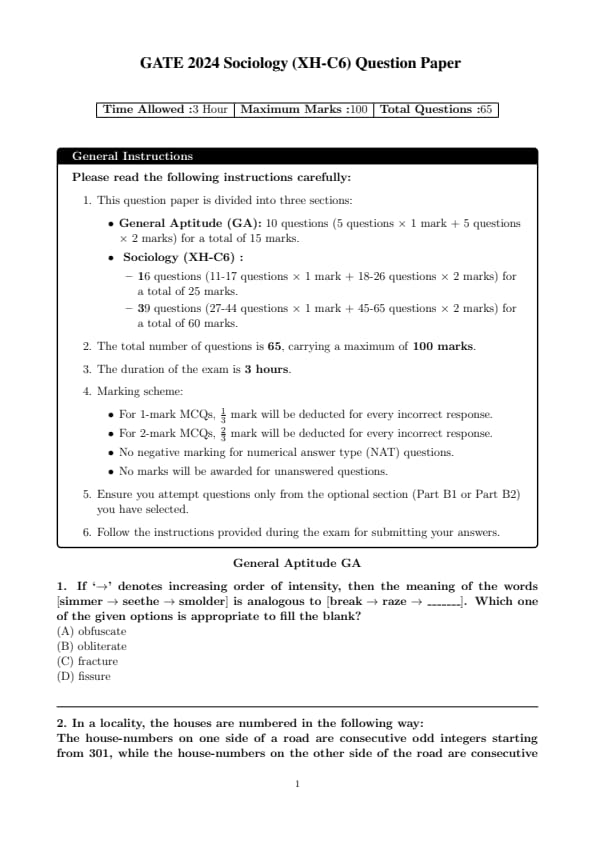

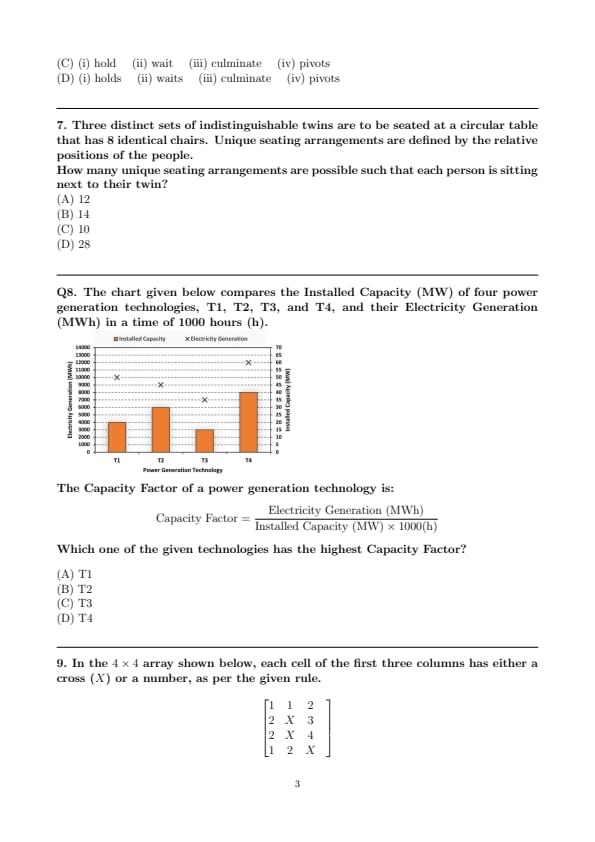
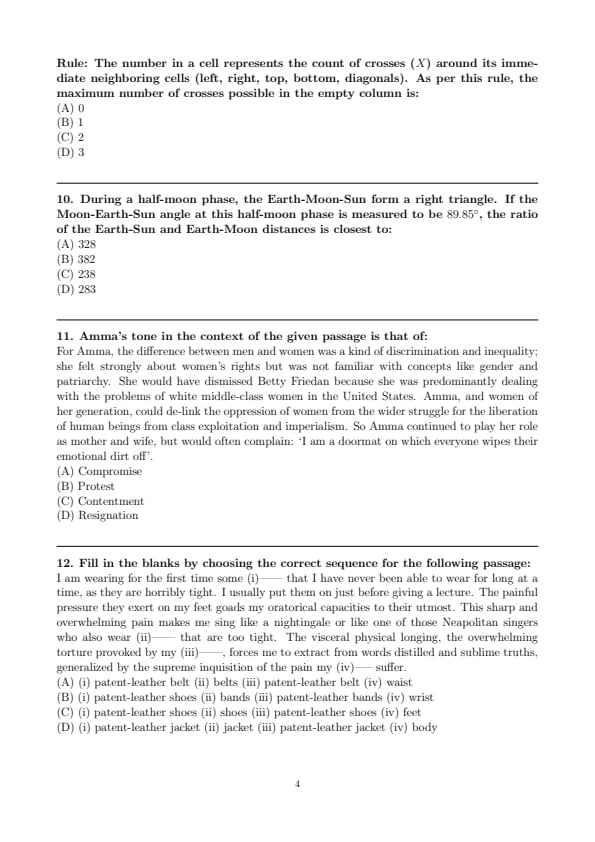

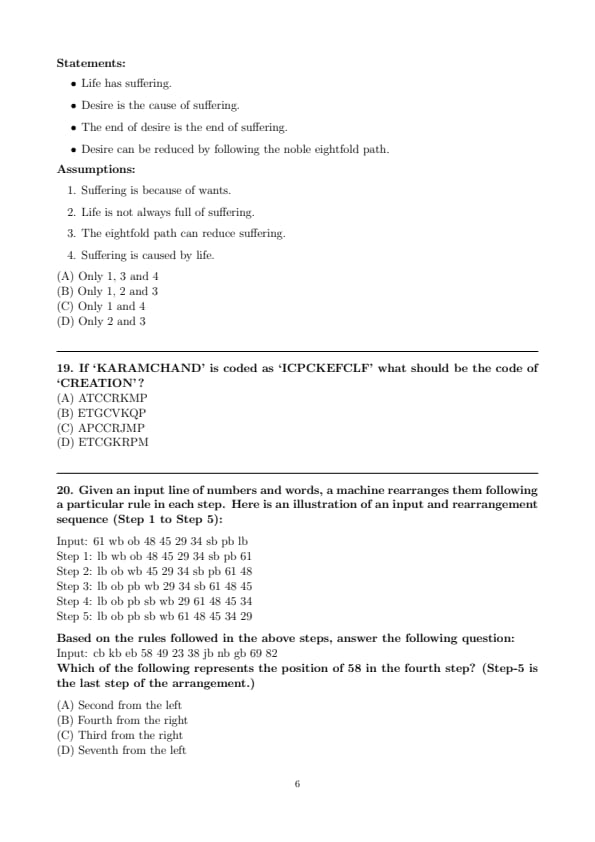
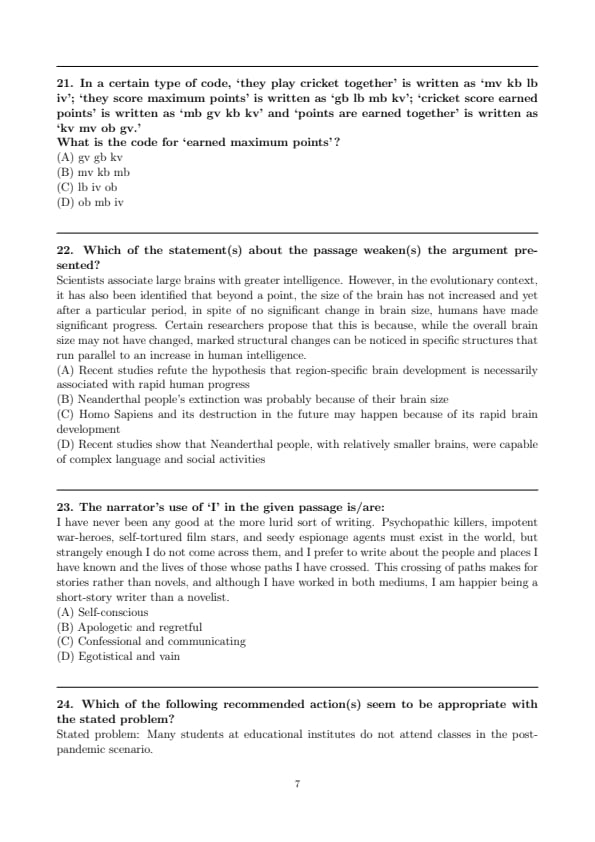


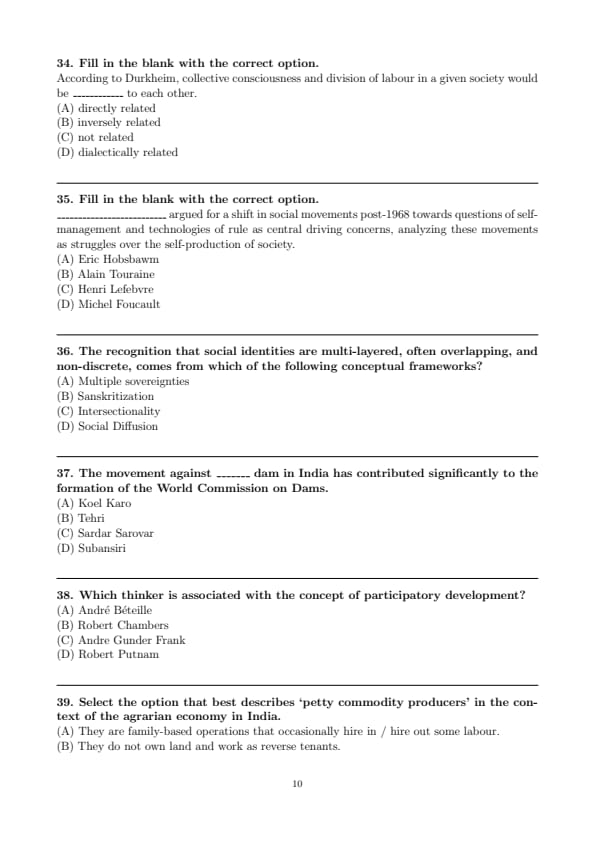


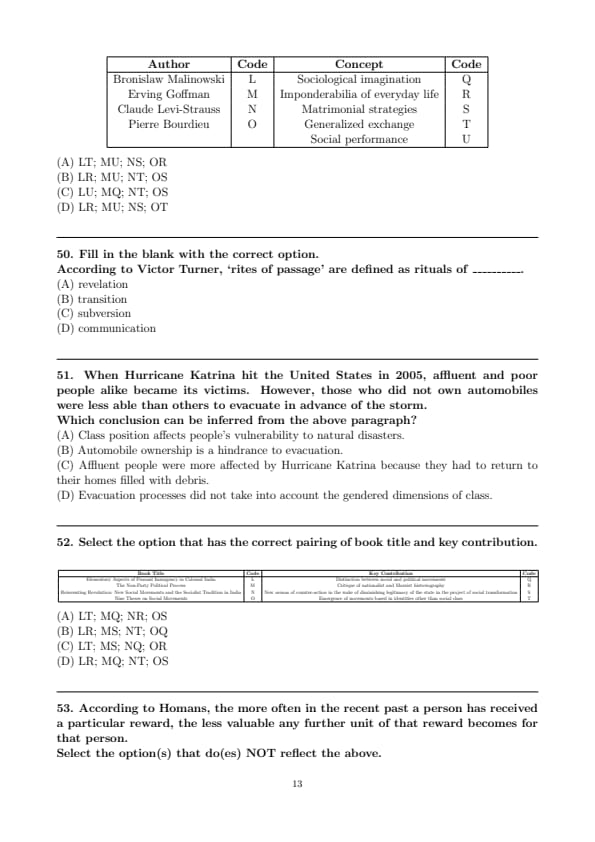






Comments